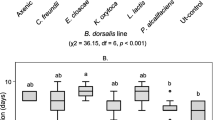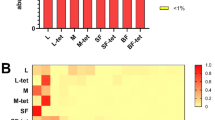Abstract
Three different bacterial species are regularly described from tsetse flies. However, no broad screens have been performed to investigate the existence of other bacteria in this medically and agriculturally important vector insect. Utilising both culture dependent and independent methods we show that Kenyan populations of Glossina fuscipes fuscipes harbour a surprising diversity of bacteria. Bacteria were isolated from 72% of flies with 23 different bacterial species identified. The Firmicutes phylum dominated with 16 species of which seven belong to the genus Bacillus. The tsetse fly primary symbiont, Wigglesworthia glossinidia, was identified by the culture independent pathway. However, neither the secondary symbiont Sodalis nor Wolbachia was detected with either of the methods used. Two other bacterial species were identified with the DNA based method, Bacillus subtilis and Serratia marcescens. Further studies are needed to determine how tsetse flies, which only ever feed on vertebrate blood, pick up bacteria and to investigate the possible impact of these bacteria on Glossina longevity and vector competence.




Similar content being viewed by others
References
Akman L, Yamashita A, Watanabe H, Oshima K, Shiba T, Hattori M, Aksoy S (2002) Genome sequence of the endocellular obligate symbiont of tsetse flies, Wigglesworthia glossinidia. Nat Genet 32:402–407
Amann RI, Ludwig W, Schleifer KH (1995) Phylogenetic identification and in situ detection of individual microbial-cells without cultivation. Microbiol Rev 59:143–169
Ash C, Farrow JA, Dorsch M, Stackebrandt E, Collins MD (1991) Comparative analysis of Bacillus anthracis, Bacillus cereus, and related species on the basis of reverse transcriptase sequencing of 16S rRNA. Int J Syst Bacteriol 41:343–346
Azambuja P, Feder D, Garcia ES (2004) Isolation of Serratia marcescens in the midgut of Rhodnius prolixus: impact on the establishment of the parasite Trypanosoma cruzi in the vector. Exp Parasitol 107:89–96
Azambuja P, Garcia ES, Ratcliffe NA (2005) Gut microbiota and parasite transmission by insect vectors. Trends Parasitol 21:568–572
Baker GC, Smith JJ, Cowan DA (2003) Review and re-analysis of domain-specific 16S primers. J Microbiol Methods 55:541–555
Baumann P, Moran NA (1997) Non-cultivable microorganisms from symbiotic associations of insects and other hosts. Antonie Van Leeuwenhoek Int J Gen 72:39–48
Cole JR, Chai B, Farris RJ, Wang Q, Kulam SA, McGarrell DM, Garrity GM, Tiedje JM (2005) The Ribosomal Database Project (RDP-II): sequences and tools for high-throughput rRNA analysis. Nucleic Acids Res 33:294–296
Dale C, Welburn SC (2001) The endosymbionts of tsetse flies: manipulating host–parasite interactions. Int J Parasitol 31:628–631
Dillon RJ, Dillon VM (2004) The gut bacteria of insects: nonpathogenic interactions. Annu Rev Entomol 49:71–92
Dillon RJ, Webster G, Weightman AJ, Dillon VM, Blanford S, Charnley AK (2008) Composition of Acridid gut bacterial communities as revealed by 16S rRNA gene analysis. J Invertebr Pathol 97:265–272
Dong Y, Manfredini F, Dimopoulos G (2009) Implication of the mosquito midgut microbiota in the defense against malaria parasites. PLoS Pathog 5:e1000423
Dorigo U, Volatier L, Humbert JF (2005) Molecular approaches to the assessment of biodiversity in aquatic microbial communities. Water Res 39:2207–2218
Eck RV, Dayhoff MO (1966) Atlas of protein sequence and structure. National Biomedical Research Foundation, Silver Springs, MD
Felsenstein J (1985) Confidence limits on phylogenies: an approach using the bootstrap. Evolution 39:783–791
Forney LJ, Zhou X, Brown CJ (2004) Molecular microbial ecology: land of the one-eyed king. Curr Opin Microbiol 7:210–220
Geiger A, Ravel S, Frutos R, Cuny G (2005) Sodalis glossinidius (Enterobacteriaceae) and vectorial competence of Glossina palpalis gambiensis and Glossina morsitans morsitans for Trypanosoma congolense savannah type. Curr Microbiol 51:35–40
Geiger A, Ravel S, Mateille T, Janelle J, Patrel D, Cuny G, Frutos R (2007) Vector competence of Glossina palpalis gambiensis for Trypanosoma brucei s.l. and genetic diversity of the symbiont Sodalis glossinidius. Mol Biol Evol 24:102–109
Geiger A, Fardeau ML, Grebaut P, Vatunga G, Josenando T, Herder S, Cuny G, Truc P, Ollivier B (2009) First isolation of Enterobacter, Enterococcus, and Acinetobacter spp. as inhabitants of the tsetse fly (Glossina palpalis palpalis) midgut. Infect Genet Evol 9:1364–1370
Gonzalez-Ceron L, Santillan F, Rodriguez MH, Mendez D, Hernandez-Avila JE (2003) Bacteria in midguts of field-collected Anopheles albimanus block Plasmodium vivax sporogonic development. J Med Entomol 40:371–374
Grice EA, Kong HH, Renaud G, Young AC, Bouffard GG, Blakesley RW, Wolfsberg TG, Turner ML, Segre JA (2008) A diversity profile of the human skin microbiota. Genome Res 18:1043–1050
Grice EA, Kong HH, Conlan S, Deming CB, Davis J, Young AC, Bouffard GG, Blakesley RW, Murray PR, Green ED, Turner ML, Segre JA (2009) Topographical and temporal diversity of the human skin microbiome. Science 324:1190–1192
Kaaya GP, Darji N (1989) Mortality in adult tsetse, Glossina morsitans morsitans, caused by entomopathogenic bacteria. J Invertebr Pathol 54:32–38
Lehane MJ (2005) Biology of blood-sucking in insects, 2nd edn. Cambridge University Press, Cambridge
Lindh JM (2007) Identification of bacteria associated with malaria mosquitoes—their characterisation and potential use. Stockholm University, Stockholm
Lindh JM, Terenius O, Faye I (2005) 16S rRNA gene-based identification of midgut bacteria from field-caught Anopheles gambiae sensu lato and A. funestus mosquitoes reveals new species related to known insect symbionts. Appl Environ Microb 71:7217–7223
Lindh JM, Borg-Karlson AK, Faye I (2008) Transstadial and horizontal transfer of bacteria within a colony of Anopheles gambiae (Diptera: Culicidae) and oviposition response to bacteria-containing water. Acta Trop 107:242–250
Matthew CZ, Darby AC, Young SA, Hume LH, Welburn SC (2005) The rapid isolation and growth dynamics of the tsetse symbiont Sodalis glossinidius. FEMS Microbiol Lett 248:69–74
Maudlin I, Welburn SC, Mehlitz D (1990) The relationship between rickettsia-like-organisms and trypanosome infections in natural populations of tsetse in Liberia. Trop Med Parasitol 41:265–267
Mayer MS, James JD (1969) Attraction of Aedes aegypti (L.): responses to human arms, carbon dioxide, and air currents in a new type of olfactometer. Bull Entomol Res 58:629–642
Mercado TI, Colon-Whitt A (1982) Lysis of Trypanosoma cruzi by Pseudomonas fluorescens. Antimicrob Agents Chemother 22:1051–1057
Mrazek J, Strosova L, Fliegerova K, Kott T, Kopecny J (2008) Diversity of insect intestinal microflora. Folia Microbiol 53:229–233
Muhling M, Woolven-Allen J, Murrell JC, Joint I (2008) Improved group-specific PCR primers for denaturing gradient gel electrophoresis analysis of the genetic diversity of complex microbial communities. ISME J 2:379–392
Muyzer G, Smalla K (1998) Application of denaturing gradient gel electrophoresis (DGGE) and temperature gradient gel electrophoresis (TGGE) in microbial ecology. Antonie Van Leeuwenhoek Int J Gen 73:127–141
Nei M, Kumar S (2000) Molecular evolution and phylogenetics. Oxford University Press, New York
Nocker A, Burr M, Camper AK (2007) Genotypic microbial community profiling: a critical technical review. Microb Ecol 54:276–289
Poinar GO Jr, Wassink HJ, Leegwater-van der Linden ME, van der Geest LP (1979) Serratia marcescens as a pathogen of tsetse flies. Acta Trop 36:223–227
Pumpuni CB, Beier MS, Nataro JP, Guers LD, Davis JR (1993) Plasmodium falciparum—inhibition of sporogonic development in Anopheles stephensi by Gram-negative bacteria. Exp Parasitol 77:195–199
Shaw MK, Moloo SK (1991) Comparative-study on rickettsia-like organisms in the midgut epithelial-cells of different Glossina species. Parasitology 102:193–199
Sheffield VC, Cox DR, Lerman LS, Myers RM (1989) Attachment of a 40-base-pair G+C-rich sequence (Gc-Clamp) to genomic DNA fragments by the polymerase chain-reaction results in improved detection of single-base changes. PNAS 86:232–236
Tamura K, Dudley J, Nei M, Kumar S (2007) MEGA4: Molecular Evolutionary Genetics Analysis (MEGA) software version 4.0. Mol Biol Evol 24:1596–1599
Waage JK (1979) The evolution of insect/vertebrate associations. Biol J Linn Soc 12:187–224
Walshe DP, Ooi CP, Lehane MJ, Haines LR (2009) The enemy within: interactions between tsetse, trypanosomes and symbionts. Adv Insect Physiol 37:119–175
Ward DM, Weller R, Bateson MM (1990) 16s ribosomal-RNA sequences reveal numerous uncultured microorganisms in a natural community. Nature 345:63–65
Weisburg WG, Barns SM, Pelletier DA, Lane DJ (1991) 16S ribosomal DNA amplification for phylogenetic study. J Bacteriol 173:697–703
Welburn SC, Maudlin I (1999) Tsetse–typanosome interactions: rites of passage. Parasitol Today 15:399–403
Welburn SC, Arnold K, Maudlin I, Gooday GW (1993) Rickettsia-like organisms and chitinase production in relation to transmission of trypanosomes by tsetse-flies. Parasitology 107:141–145
Wintzingerode Fv, Gobel UB, Stackebrandt E (1997) Determination of microbial diversity in environmental samples: pitfalls of PCR-based rRNA analysis. FEMS Microbiol Rev 21:213–229
Zahner V, Lucarotti CJ, McIntosh D (2008) Application of 16S rDNA-DGGE and plate culture to characterization of bacterial communities associated with the sawfly, Acantholyda erythrocephala (Hymenoptera, Pamphiliidae). Curr Microbiol 57:564–569
Zientz E, Silva FJ, Gross R (2001) Genome interdependence in insect–bacterium symbioses. Genome Biol 2:reviews1032
Acknowledgments
We thank Lee Haines for providing Sodalis glossinidius DNA and Rod Dillon, Naomi Dyer and Stella Lehane for technical assistance, discussions and support. The study was funded by the European Commission INCO programme.
Conflict of interest
The authors declare that they have no conflict of interest.
Author information
Authors and Affiliations
Corresponding author
Rights and permissions
About this article
Cite this article
Lindh, J.M., Lehane, M.J. The tsetse fly Glossina fuscipes fuscipes (Diptera: Glossina) harbours a surprising diversity of bacteria other than symbionts. Antonie van Leeuwenhoek 99, 711–720 (2011). https://doi.org/10.1007/s10482-010-9546-x
Received:
Accepted:
Published:
Issue Date:
DOI: https://doi.org/10.1007/s10482-010-9546-x




